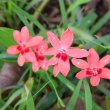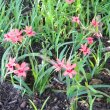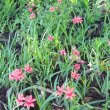| Botanical Name |
|
| Family |
Iridaceae - The iris family. |
| Pronunciation |
|
| Common Name(s) |
English: False Freesia; African Lapeirousia
|
| Plant Group |
- Bulb / Corm / Rhizome / Tuber / Epigeal bulb Bulbs: are made up of fleshy scales as in an onion
Corm: a short, swollen, underground stem that is hard and not fleshy as in a gladiolus
Tuber: a solid, fleshy, underground, storage organ as in a potato
Rhizome: an underground, horizontal, swollen stem at the base of the plant as in an iris
Epigeal bulb: bulbs that rest above the ground with only the roots anchoring the plant to the earth as in albuca
|
| Plant Size |
- Very Small
| Tree | 3m to 4m |
| Shrub | 25cm to 50cm |
| Perennial/ground cover | Up to 10cm |
| Bulb | 10cm to 20cm |
| Succulent | Up to 5cm |
|
| Position |
- Canopy Shade Canopy shade is found below closely grown trees where some light filters through. Ideal for the protection of herbaceous plants.
- Light or Dappled Shade Found below trees with sparse, open foliage. Ideal for the protection of herbaceous plants.
- Partial Shade The area is in shade for part of the day and in full sun for part of the day.
- Sun The area is in full sun for all or most of the day, all year round.
|
| General Information |
- Deciduous Plants which completely lose their foliage for part of the year.
- Drought Tolerance: Moderate The plant is moderately adapted to arid conditions and can survive short periods of drought and high temperatures without extra water.
- Frost: Hardy The plant can withstand freezing temperatures or frost without artificial protection.
- Water Moderate These plants will need some extra watering compared to water-wise plants. Plant them together, in at least some shade and in a convenient proximity to the house so that grey water can be utilised during times of drought.
- Water Wise Plant species originating from low rainfall regions that require less water to survive and thrive than other plant species.
|
| Specific Information |
Previously known as Lapeirousia laxa. In spring each corm produces a clump of flat, grass-like green leaves growing up to 20 cm tall. This is a low maintenance plant that prefers soil with a low fertility. It grows well in a slightly shady position in hot and dry areas, although they will grow in full sun in cooler climates. Plants go dormant after flowering, being completely dormant by the end of autumn. They may also go dormant if the weather becomes very hot and dry in summer. A tolerant bulb that can be watered all year round without harm in areas where there is no chance of the ground freezing. Plants are easy to propagate by offsets from the original parent bulb, and when grown from seeds they can flower in as little as 6 months from sowing. Germination is quick and abundant. This is an easy way to grow them en masse.
|
| Ad Break |
|
| Flowers |
| Description |
upward-facing, six petals, starry, trumpet-shaped flowers with dark red splotches at the bases of the lower three petals
|
| Season |
- Spring to Summer Plants will seldom bloom for the entire season as given in the list, but should flower during a period within these parameters.
|
| Colour |
|
| Growth Rate |
- Fast Specifying growth rate can be very misleading as there is considerable variation of growth rate depending on type and species of plant, available water, supplementary feeding, mulching and general care, as well as the plants suitability and adaptability to the garden environment.
|
| Plant Uses |
- Attracts bees, butterflies or other insects This plant attracts insects which can be food for birds or other creatures in your garden.
- Bedding Plants, usually annuals, suitable for mass planting in beds for their quick colourful flowers or foliage and used to form a temporary display.
- Border A strip of ground, at the edge of a driveway or path in which ornamental plants or shrubs are planted.
- Container Trees, shrubs and ornamental species that can adapt to growing in a restricted environment.
- Edging A low growing plant that provides softness or definition to the edges of a bed or walkway.
- Filler Either a fast growing tree or shrub used temporarily to fill in an area while the permanent plants grow to a desired size, or a plant used to fill gaps in borders or beds.
- Ground Cover Low-lying plants that spread fast, require minimal maintenance, and cover large expanses or bare areas between bulbs or shrubs. They provide protection from erosion and drought and improve the visual appearance of the garden.
- Interplanting Arranging and planting plants in the garden that have different blooming times and habits of growth, extending the amount of time in which the area is in flower.
- Mass Planting Plants useful for filling a large area with just one or a few kinds of plants spaced close together. Creates a bold, dramatic effect and to reduces maintenance.
- Pot Plant A plant that needs a protected environment on a patio or indoors.
- Rock Garden An area constructed of larger rocks, arranged naturally, to emphasise the use of stones as a main element. Generally plants used do not need a lot of care.
- Stabilize Banks Plant is used to prevent soil erosion because their roots will form a mat that stabilizes the soil and keeps it from washing away in heavy rains.
- Suitable for coastal gardens Plants adapted to dry, sandy soil, forceful wind, limited rainfall and intense sunlight.
- Suitable for smaller gardens Such plants do not have invasive root systems, remain small or controllable and can often be grown in containers.
- Wild Garden An indigenous garden planted for the benefit of wildlife and birds. Provides food, water, a variety of mini-biomes and no poisonous chemicals are used.
|
| Distribution and Habitat |
Eastern Cape, KwaZulu-Natal, Limpopo, and Mpumalanga in South Africa, as well as Mozambique, in grasslands
|
| Planting Suggestions |
Plant directly in the ground (2cm deep) in autumn or late winter in well-drained, sandy soil, in full sun or light shade. The plant thrives in soil with low fertility. They perform best with moderate but consistent moisture during the growing season. Propagate by dividing corms in winter (which is a bit fiddly as they are quite small). Alternatively allow the plants to seed themselves or collect the seeds and plant them in trays. Plant seedlings out the following winter when the corms are large enough to handle.
|
| Medicinal Uses |
|
| Ad Break |
|







Discuss this plant
Share knowledge, ask a question or give an experience.